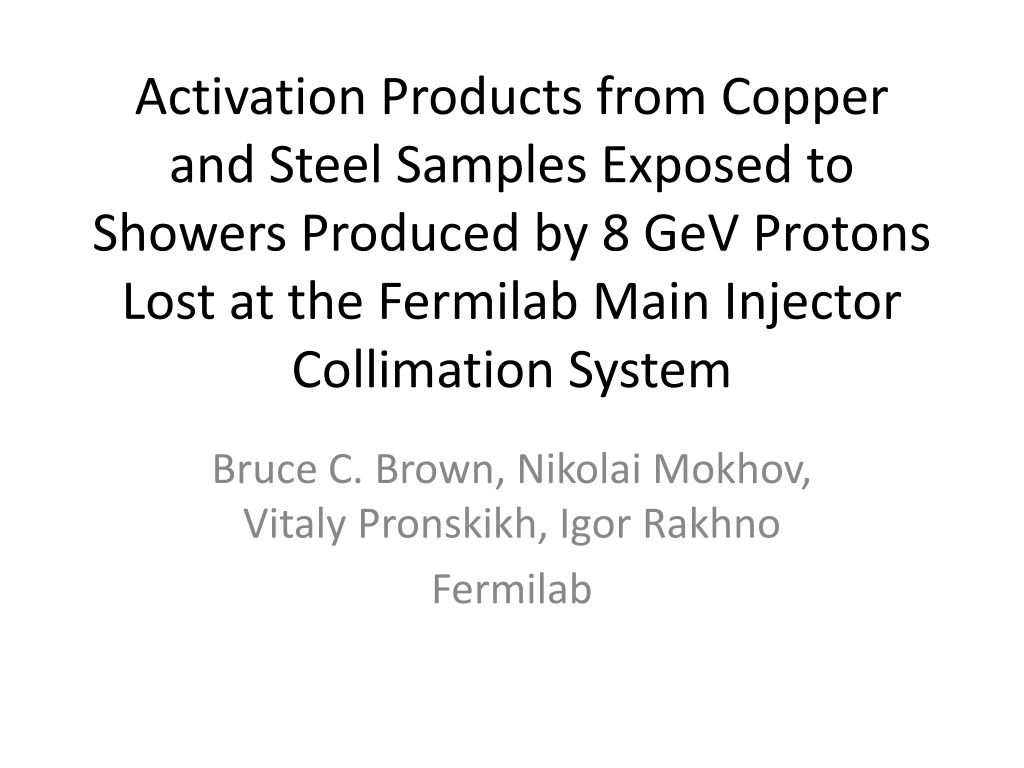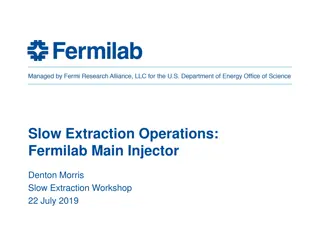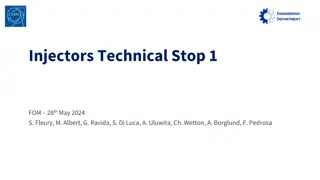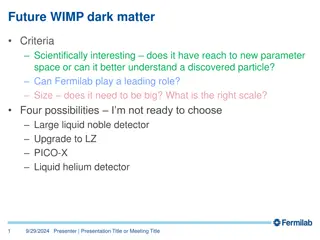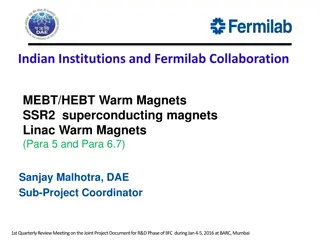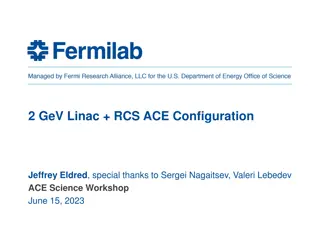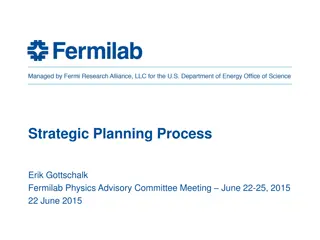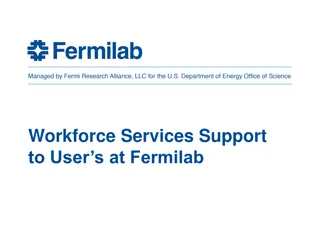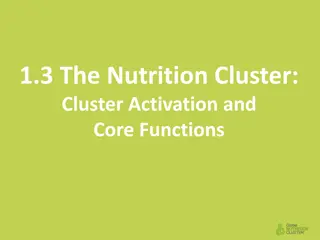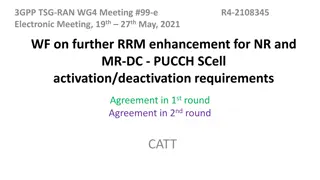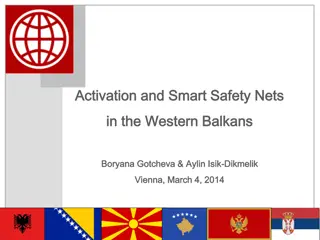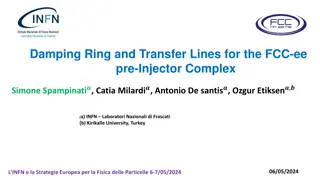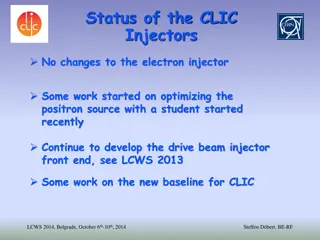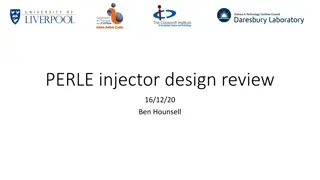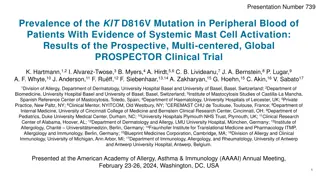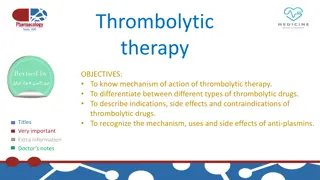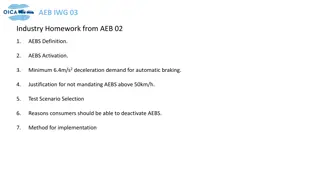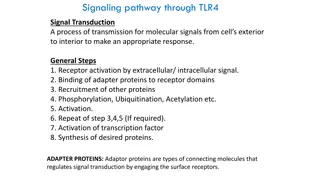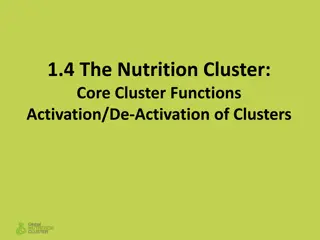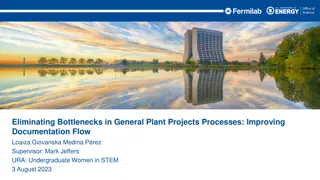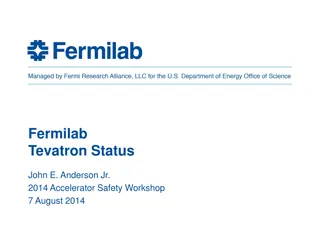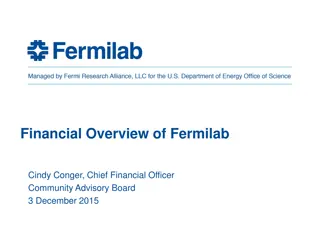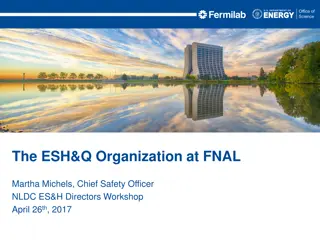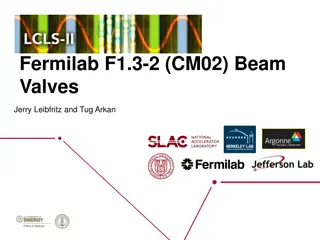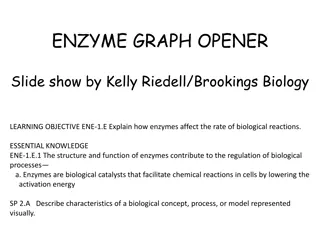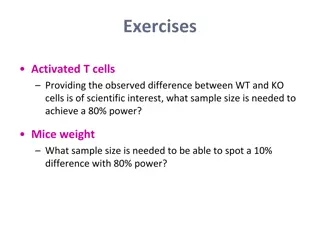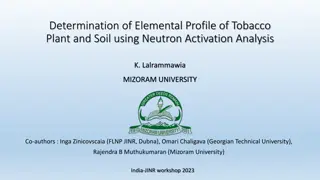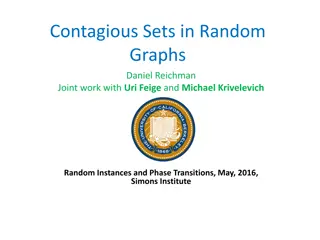Activation Products Analysis at Fermilab Main Injector
Explore the study on activation products from copper and steel samples exposed to showers produced by 8 GeV protons at Fermilab Main Injector Collimation System. Delve into radiation issues, maintenance planning, and fitting formulas to analyze residual radiation using half-life weighted beam loss. Discover insights on isotopes control and cooldown strategies.
Download Presentation

Please find below an Image/Link to download the presentation.
The content on the website is provided AS IS for your information and personal use only. It may not be sold, licensed, or shared on other websites without obtaining consent from the author. Download presentation by click this link. If you encounter any issues during the download, it is possible that the publisher has removed the file from their server.
E N D
Presentation Transcript
Activation Products from Copper and Steel Samples Exposed to Showers Produced by 8 GeV Protons Lost at the Fermilab Main Injector Collimation System Bruce C. Brown, Nikolai Mokhov, Vitaly Pronskikh, Igor Rakhno Fermilab
Operation of Fermilab Main Injector Main Injector 1999-2004 Fixed Target and Collider Operation ~0.5x1018p/week with >97% efficiency 2005-2012 Collider + Neutrinos (NuMI) >10x1018p/week with 91% - 94% efficiency Repairs:2 24 hours Maintenance: 8 56 hours Facility Upgrades: 13, 10, 13, 5, >60 weeks 4/28/2014 SATIF-12 2
Radiation Issues for Hands-on Maintenance in Fermilab Main Injector Planning for Maintenance => ALARA Radiation Issues: Identify, Characterize, Control Monitor at Bar-Coded 126 locations from 2005 Collimation 2006 in Injection Line (PAC07) -- 2007 in MI Ring (HB2008) Characterize Activation/Cooldown 2010 (HB2010) Fix Minor (and some not-so-minor) problems __________________________________________________ The Fermilab Main Injector: high intensity operation and beam loss control Bruce C. Brown, Philip Adamson, David Capista, Weiren Chou, Ioanis Kourbanis, Denton K Morris, Kiyomi Seiya, Guan Hong Wu, Ming-Jen Yang (Fermilab). Jul 10, 2013. 16 pp. Published in Phys.Rev.ST Accel.Beams 16 (2013) 7, 071001 FERMILAB-PUB-12-640-AD 4/28/2014 SATIF-12 3
Formulas for Fitting The BLM system records (for each monitor) a loss integral (LI) for each MI Cycle. We sum these over ten minute intervals (Ts = 600 sec) to quantas, LIj. For each isotope we sum these quantas weighted by the half-life The fitting hypothesis assumes that the measured residual radiation at measurement time, TM is a linear sum of the weighted quata sums over the set of isotopes The physics of the loss pattern and isotope production, loss monitor geometry, bar code monitor location geometry and Geiger tube energy response multiply to create one linear constant EI. 28 September 2010 4/28/2014 BCBrown, HB2010, MI Res Rad and Losses SATIF-12 4 4
Fit Residual Radiation using Half-life weighted Beam Loss Nearby Fit using Mn-54 Mn-52 Mn-56 4/28/2014 SATIF-12 5
What Isotopes Control Cooldown? For goal of ALARA planning, crude fit with three isotopes was sufficient: Mn-54 (312 days), Mn-52 (5.591 days) Mn-56 (2.5789 hours) But a careful cooldown study showed that some intermediate half life isotopes were important. For a cross-check of MARS simulations, Al Tag activation studies were also being done. Discovered HPGe Spectrometer was available ! 4/28/2014 SATIF-12 6
Activate Samples at Collimator Secondary Collimators absorb lost 8 GeV Protons in Stainless Vacuum Liner. Secondary flux attenuated by 2.5 cm Stainless Steel, 50 cm Steel and 12 cm Marble. Steel and Cu Tags placed at same location as Geiger Tube in these photos. Unshielded Location (Forward) Shielded Location (Side) 4/28/2014 SATIF-12 7
Disks for Activation Study Table 1: Nominal Parameters for 1.5 Activation Analysis Disks Aluminum Disks Density Diameter Mass Volume Thickness 2.7 1.5 2.31 0.86 0.08 gm/cm3 in gm 38.1 mm cm3 cm 29.54 mils Steel Disks Density Thickness Diameter Volume Mass 7.85 gm/cm3 mils 60 1.52 38.1 mm mm 1.5 1.74 13.64 in cm3 gm Cu Disks Density Thickness Diameter Volume Mass 8.94 gm/cm3 mils 44 1.12 38.1 mm mm 1.5 1.27 11.39 in cm3 gm 4/28/2014 SATIF-12 8
Chemical Analysis of Magnet Steel weight percent Uncertainty on weight % Std Atomic Weight molar percent molar fraction Element Fe Balance 55.845 9.907E-01 C 0.0033 0.0008 12.0107 0.000709738 7.097E-06 Mn 0.5200 0.0100 54.938045 0.5115549 5.116E-03 P 0.0510 0.0030 30.973762 0.028286541 2.829E-04 S 0.0060 0.0010 32.065 0.003445071 3.445E-05 Si 0.3600 0.0100 28.0855 0.181050766 1.811E-03 Al 0.2760 0.0290 26.9815386 0.133349533 1.333E-03 N 0.0023 0.0002 14.0067 0.000576872 5.769E-06 Sb 0.0330 0.0027 121.76 0.071950577 7.195E-04 4/28/2014 SATIF-12 9
Activation Studies Placed samples at Shielded and Unshielded locations for periods from 4 to 50 days. HPGe spectrometer is limited to 1 mRem/hr during reading. For short half life isotope measurement we employed small nubs cut from our stock of 1.5 disk materials. Coordinated placement and retrieval of samples with storage of antiprotons in the Recycler ring which is in the Main Injector tunnel. 4/28/2014 SATIF-12 10
Report from Radionuclide Analysis Facility 4/28/2014 SATIF-12 11
Activity => Activation o Cannot measure short half life isotopes with sample exposure which give best results for long half life. o For comparison with MARS, would like normalization to protons lost at collimator. Normalization Options o Nearby BLM (LI307 for these studies) o Hadron fluence with Al Tag Activation. o Protons lost (by calibration of BLM) 4/28/2014 SATIF-12 12
Analysis Formulas NA Iln 2 ?? ?1/2 3.7?10 2 = ??ln 2 Activity Produced SA(pCi/gm) = ?1/2 ?? ?)? ?? ? Activity Produced w/ Decay NA I ln 2 ?? ?1/2 3.7?10 2 ?? ?? (1-? SA(pCi/gm) = Normalize either Produced Activity after decay correction to total fluence or Production Rate to flux. 4/28/2014 SATIF-12 13
Weighting for Activation Details Using loss history weighted for isotope half life LW (I, TM) or the comparable un-weighted sum L ???? ??? ??????????? ?? ?(?,??) ??(?,??) = = ????????????? As defined, L and LW are rates in Rads/sec. Can also normalize to LWu and Lu by multiplying by the lifetime I = t ln 2. 4/28/2014 SATIF-12 14
Copper Sample Results Normalized to Weighted Sums for Loss Monitor LI307 Sample Half Life days Shielded Shielded Unshielded Cu #1617 Cu 13/16 Cu 7/32 Cu 7/32 / Cu#1617 SA/LW (pCi/gm)/(Rad/sec) Ag-110m 249.95 2.0437E+05 Au-198 2.69517 9.8701E+03 Co-55 0.730417 3.8852E+05 Co-56 77.233 2.2946E+04 4.6425E+06 2.0232E+02 Co-57 271.74 1.2002E+05 1.3501E+07 1.1249E+02 Co-58 70.86 1.9304E+05 4.8881E+05 2.1993E+07 1.1393E+02 Co-60 1925.8 1.3154E+05 Cr-51 27.7 2.0319E+04 Cu-61 0.1389 1.9978E+07 Cu-64 is Dominant Isotope Cu-64 0.52917 2.6090E+08 6.2781E+08 4.9439E+08 1.8949E+00 Fe-59 44.5 1.3874E+04 K-43 0.9292 2.0923E+05 Mn-52 5.591 8.6647E+03 1.5780E+04 1.6017E+06 1.8486E+02 Mn-54 312.2 4.8838E+04 Mn-56 0.1074 2.7428E+06 Na-24 0.62329 6.1163E+04 Ni-57 1.483 3.7067E+05 Sc-44m 2.44 3.7668E+05 Sc-47 3.341 2.2177E+05 Sc-48 1.82 1.3058E+05 Se-75 119.779 6.8359E+03 Secular Equilibrium? No Long Half Life Isotopes Ti-44/Sc-44 17275.85 2.3386E+09 V-48 15.98 5.3139E+03 8.2708E+05 1.5564E+02 SATIF-12 4/28/2014 15 Sc-44 0.165417 5.5261E+05
Steel Sample Results Normalized to Weighted Sums for Loss Monitor LI307 Sample Half Life days St #011 Shielded St #001 Shielded St 13/16 Shielded St 7/32 Unsh Secular Equilibrium? No Long Half Life Isotope SA/LW (pCi/gm)/(Rad/sec) Ar-42/K-42 Br-76 Co-60 Cr-48 Cr-51 Fe-52 Fe-59 K-43 Mn-52 Mn-54 Mn-56 Na-24 Sb-122 Sb-124 Sc-44m Sc-46 Sc-47 Sc-48 Ti-44/Sc-44 V-48 Sc-44 K-42 4/28/2014 12020.4 0.675 1925.8 0.8983 27.7 0.34479 44.5 0.9292 5.591 312.2 0.1074 0.62329 2.7 60.2 2.44 83.83 3.341 1.82 17275.85 15.98 0.165417 0.515 1.6715E+09 1.9640E+04 1.5009E+05 1.2689E+05 2.2483E+05 2.8584E+07 2.5584E+05 2.7771E+05 2.9005E+05 2.8482E+05 1.2668E+03 3.4429E+05 Activate Fe-58 to Fe-59 !!! 3.1089E+05 3.2703E+05 3.2431E+05 8.1052E+06 6.3507E+07 3.0780E+07 2.4362E+05 1.0579E+06 7.8784E+04 6.4859E+05 8.6647E+04 6.3301E+05 7.1730E+04 6.3673E+05 6.7716E+06 4.1047E+03 5.1685E+05 6.0953E+04 3.1531E+03 Mn-54 Mean/Sigma = 1.27% 5.5215E+05 2.8151E+05 7.7390E+03 1.5582E+04 8.4731E+03 1.6546E+03 4.6064E+06 5.0970E+04 6.5241E+03 5.8856E+05 2.6412E+05 5.2634E+03 1.8122E+04 1.2754E+04 Antimony Activation !!! 1.4043E+06 3.6293E+06 1.3634E+06 2.2196E+05 1.2218E+10 7.0597E+06 2.8871E+06 3.9625E+05 9.8253E+03 2.4429E+03 2.5732E+07 4.2489E+04 1.4236E+04 Secular Equilibrium? No Long Half Life Isotope 4.8654E+04 SATIF-12 16
Averaged Results for Al Tags Tags to average # Fluence/LW SA/LW RMS/Mean (hadrons/cm2 /(Rad/sec)) (pCi/g)/(Rad/sec) Unshielded 5 7.9475E+07 0.705 1.546E+18 Unshielded(Exclude #5955) 4 5.5247E+07 0.302 1.074E+18 Unshielded(Exclude #5955,#1612) 3 6.3291E+07 0.085 1.231E+18 Shielded 8 1.4827E+05 0.144 2.884E+15 Shielded (Inst 2011) 4 1.5669E+05 0.153 3.0473E+15 Shielded (Inst 2007) 4 1.3984E+05 0.125 2.7198E+15 4/28/2014 SATIF-12 17
Revelations Needed to add Cr-51 and Fe-59 to cooldown fits. Tiny Admixture of Sb (antimony) is significant. Co-60 is measured but not huge. 4/28/2014 SATIF-12 18
Steel Spectrum 1000 1325 keV Fe-59 1099.45 keV 4766 79 Counts Fe-59 1291.60 keV 3053 61 Counts V-48 1312.05 keV 2039 51 Counts 4/28/2014 SATIF-12 19
Steel Spectrum 490 820 keV Sb-122 564.37 keV 37260 137 Counts Sb-124 602.73 keV 9115 107 Counts Mn-52 744.23 keV 5891 90 Counts Sb-124 645.6 keV 698 50 Counts 4/28/2014 SATIF-12 20
Compare MARS to Measured Steel Shielded 1 Cr Mn V Mn Sc Sc Sc Sc Fe 0.1 Ratio to Mn-54 Activation MARS Meas 0.01 0.001 4/28/2014 SATIF-12 21
Acknowledgments Fermilab Main Injector Department Accelerator Operations and Operations Co- coordinators Cons Gattuso and Mary Convery Accelerator Radiation Safety Gary Lauten Radiation Analysis Facility Vernon Cupps (retired), Meka Francis, Matt Quinn 4/28/2014 SATIF-12 22
